Equipment that is listed by a certification organization such as Underwriters Laboratories (UL) provides peace of mind to millions of consumers, workers, installers, authorities having jurisdiction (AHJs) and insurance companies that the equipment has complied with established safety requirements. This is recognized all over industry and the marketplace where protecting the health and safety of the general public and those in the workplace is a priority. However, over the last couple years in places like North Carolina and South Dakota there seems to be a big push by some business owners in the name of economic development to try to get industrial equipment to be exempt from the AHJ requiring listed equipment. The desired economic development comes at what cost? This appears to be caused by them not understanding clearly the long-term value that listings provide to their business continuity and employee safety.
In this article, we will explore what is a listing or certification, what goes into a listing and why certified equipment is important in the scheme of the U.S. safety system. We’ll also discuss misconceptions and limitations of the CE marking that may appear on equipment.
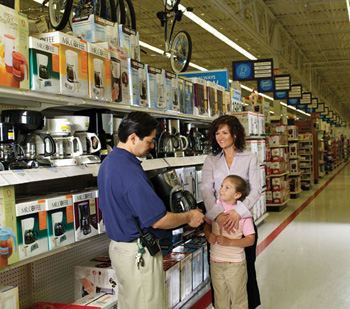
Photo 1. Consumers looking to buy a UL listed coffee maker
Myths about Listing
Let’s dispel some of the common myths about listing that are out there and then we can address why certification is important.
Myth No. 1
A listing mark has no meaning; it’s just a label you buy.
Nothing could be further from the truth. A UL Listing Mark on product is a declaration that at the time of manufacture, the product complied with all applicable UL certification requirements in effect at the time of manufacture. Authorization to apply a UL Mark can only be granted once the product has demonstrated through evaluation and test that the product complies with the applicable nationally recognized safety standard or requirements. Once compliance has been demonstrated, the manufacturer must agree to unannounced ongoing follow-up factory inspections to verify continued compliance with UL requirements.
Myth No. 2
Any old listing mark will do on a product; it doesn’t matter what it is listed for.
That myth is also not true. A product has to be listed for the type of application it is used for. You wouldn’t want to use an ordinary location panelboard in a hazardous classified location in a gasoline refinery. One of the AHJ’s duties is to verify that a listed product is being used in accordance with its listing. The AHJ does this by verification that the product is installed in accordance with its installation instructions and the product category Guide Information for the Listed product located in the UL White Book.
Myth No. 3
The NEC requires everything to be listed.
TheNECactually requires very few types of product to be listed; however, it does have provisions that permit listing by a certification organization acceptable to the AHJ to be a basis for the AHJ’s approval. Most AHJs take that to heart and require that the product be listed before they sign off on the inspection. The AHJ most likely does not have the time, expertise or equipment to evaluate every product to the applicable safety requirements. That is why the AHJ leaves that to the certification organizations such as UL who are the experts in product certification.
Myth No. 4
The CE Mark is a certification mark.
Another myth that could not be further from the truth. The CE Mark is not a certification mark and has nothing to do with the North American Safety System. The CE is not a European Mark. The CE marking is a manufacturer’s self declaration of conformity to European Directives for those manufacturers selling products in the European Union to facilitate trade between member countries of the European Union.
What Does Listing Mean?
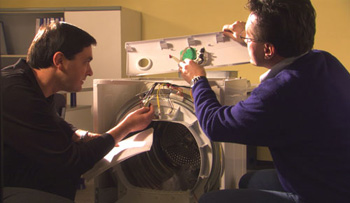
Photo 2. A UL project engineer and reviewing engineer evaluate the construction of a clothes dryer during their preliminary review of the product for compliance with the safety standard.
A UL Listing means that the product has been evaluated for compliance to the safety standard established for that category of products. The safety standard attempts to address all foreseen safety hazards specific to the type of equipment, typically relating to electric shock, risk of fire and injury to persons. The Listing Mark on the product is a declaration that the product complied with the applicable certification requirements in effect at the time of manufacture. The Mark provides confidence that the product complies with specific safety requirements and that continued compliance with those requirements is periodically verified at the factory.
A proper listing on a product goes a long way to assure a code-compliant installation. It also provides peace of mind to business owners who can be assured that this critical safety equipment, which often represents a significant investment in both initial cost and business continuity, has been evaluated to nationally recognized safety standards by a reputable nationally recognized safety organization that has been independently accredited to demonstrate expertise in this area. Listings are relied upon by insurance interests, AHJs, installers and consumers to show compliance with safety standards and codes. In addition, ensuring that their electrical equipment has been listed by an accredited certification organization, such as UL, demonstrates clearly that the business owner is acting in good faith to ensure that his equipment meets recognized safety standards, an important consideration in today’s society.
The Case for Listing

Photo 3. A UL engineer conducting EMC (electromagnetic compatibility) testing in one of UL’s state of the art EMC labs.
The U.S. Safety system is primarily a voluntary system made up of model installation codes adopted locally and enforced by over 40,000 AHJs in local municipalities. In order for the system to work properly and to safeguard the health and safety of American workers and the general public, the system relies on the crucial interaction of model installation codes, such as the NEC, certification of products to product safety standards, trained installers installing certified products in accordance with the product listing and code inspection and enforcement that verifies compliance with the code. Without any of these critical components, the system would fail, exposing American workers and public to untold safety hazards.
All code enforcement inspectors carry the heavy load of overseeing the construction of thousands of different installations every year, doing their best to assure compliance with the code they are enforcing. They have limited time and resources to achieve their ultimate goal that is detailed in the Introduction of the National Electrical Code, ANSI/NFPA 70 (NEC). NEC 90.1(A), states the purpose of the Code “is the practical safeguarding of persons and property from the hazards arising from the use of electricity.”
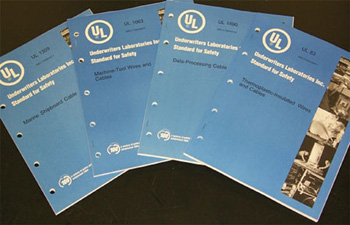
Photo 4. Just a few of the over 1000 UL Safety Standards that UL publishes.
That is why AHJs of all trades rely on the listing of equipment by a certification organization such as Underwriters Laboratories to give them peace of mind in their approval decision. They know if the product has been certified by a third party certification organization like UL, then they don’t have to re-evaluate that piece of equipment in the field, they can concentrate on the field wiring of the product because the product has been evaluated for compliance with a known nationally recognized safety standard.
The NEC
All electrical inspections, regardless of what type of equipment and application, follow a common code for inspection, in addition to the specific articles relating to the specific equipment installation. That common code includes the following sections:
90.4 Enforcement. The AHJ has the responsibility for approving an installation.
90.7 Examination of Equipment for Safety. Listing provides a basis for approval.
110.2 Approval. All wiring and installations are only acceptable if approved by the AHJ.
110.3(A) Examination provides eight considerations that shall be evaluated at a minimum for approval.
110.3(B) Listed products have to be installed in accordance with their installation instructions. This includes the installation instructions with the Listed product as well as any markings on the product and the UL Guide Information for the product category in the UL White Book.
In order for AHJs to make their approval decisions in accordance with NEC 110.2, they need to evaluate the eight considerations in accordance with NEC 110.3(A), those are:
“(1) Suitability for installation and use in conformity with the provisions of this Code.
“FPN: Suitability of equipment use may be identified by a description marked on or provided with a product to identify the suitability of the product for a specific purpose, environment, or application. Suitability of equipment may be evidenced by listing or labeling.
“(2) Mechanical strength and durability, including, for parts designed to enclose and protect other equipment, the adequacy of the protection thus provided
“(3) Wire-bending and connection space
“(4) Electrical insulation
“(5) Heating effects under normal conditions of use and also under abnormal conditions likely to arise in service
“(6) Arcing effects
“(7) Classification by type, size, voltage, current capacity, and specific use
“(8) Other factors that contribute to the practical safeguarding of persons using or likely to come in contact with the equipment”
The AHJ most likely doesn’t have the time, equipment or expertise to evaluate each piece of equipment for these considerations, yet the Code requires they evaluate these considerations. One way to do that is to require a Listed product or Field Evaluated product, where the AHJ can be confident these aspects have been evaluated and are consistent with the option provided in the FPN for 110.3(A)(1).
OSHA
The Occupational Safety & Health Administration’s mission is to assure the safety and health of America’s workers. Federal regulation 29 CFR 1910 requires that all electrical products in the workplace be listed or field evaluated by a nationally recognized testing laboratory (NRTL) such as UL. Not complying with OSHA regulations could result in substantial fines and legal action. Unfortunately, it seems that OSHA only gets involved after an injury has occurred; however, why take a chance with worker safety and repercussions from OSHA.
Overview of the Listing Process
As previously discussed, a listing means that the product has been evaluated for compliance with a nationally recognized safety standard for all foreseen safety hazards, typically relating to electric shock, fire and injury to persons. Listing provides confidence that the product complies with specific safety standards or requirements. Let’s take a closer look at standards.
What Are Product Safety Standards?

Photo 5. A UL project engineer and reviewing engineer conducting a preliminary review of a medical monitoring system for compliance with the safety standard.
Product safety standards are written prescriptive rules providing uniform and consistent construction and test methods for products being evaluated and listed. UL develops the majority of product safety standards in the U.S. by the Standards Technical Panel (STP) consensus process. Presently, there are over 1000 UL standards in existence. Throughout the past 114 years UL has been in existence, the standards writing process has maintained pace with the advances in technology and with demands of the end user/consumer.
Safety standards are intended to reduce the risk of fire, electric shock and personal injury. Life safety and fire protection equipment standards also address reliability of operation, resistance to unwanted operation and resistance to operation inhibition.
Every safety standard is different because each addresses the construction and performance criteria specific to the type of equipment the standard covers. However, while different they have a common approach to address the same hazards. A typical electrical product standard addresses:
- Scope
- Construction Criteria
- Enclosure
- Electrical Spacings
- Connection to the power supply
- Wire Bending Space
- Grounding
- Ventilation Openings
- Components
- Performance (test) requirements
- Normal conditions
- Abnormal Conditions
- Markings and instruction manual content
- Production line testing
Listing Evaluation
A typical listing evaluation is very similar to a typical electrical inspection in the sense that there are three separate stages:
Typical Electrical Inspection Typical Listing Investigation
1. Plan Review Using Code 1. Engineering Product Review
Using Safety Standard
2. Rough Installation2. Testing and Report
3. Final inspection 3. Final review, product is judged eligible for listing, factory follow up inspections
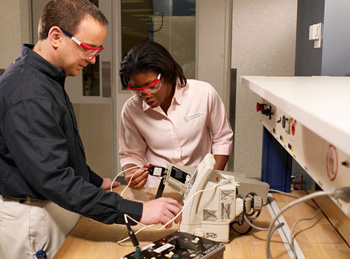
Photo 6. A UL engineer and lab technician conducting a leakage current test on medical equipment.
Stage one of an electrical inspection is the plan review stage where the electrical plan is reviewed for compliance with the code. Stage one of a listing investigation involves performing a preliminary engineering review of the product, where the construction of the product is evaluated to the applicable safety standard/requirements. The test program is also determined, and any construction issues are documented in a letter for the client. The preliminary review is conducted with two engineers reviewing the product for compliance with the standard. If everything is in order the test program is finalized, if not, then appropriate criticism reports are issued to the client to be addressed.
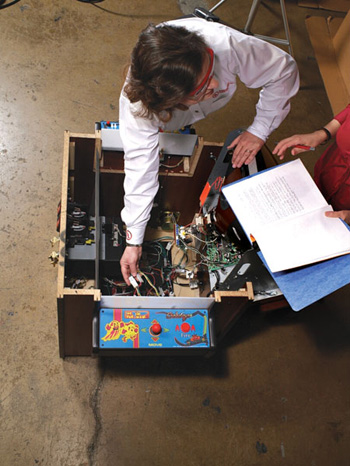
Photo 7. A UL Field Services representative verifies the construction of a video game machine for compliance with the UL report during a factory follow-up inspection. Factory follow-up inspections are conducted a minimum of four times a year to verify that the manufacturer is constructing the product in accordance with UL’s requirements
Stage two of an electrical inspection is the rough installation inspection, where the rough-in is reviewed for compliance with the code at the preliminary construction phase of the installation. Stage two of a listing investigation is when the test program is conducted, as well as a descriptive report of the product is written. The descriptive report details all the critical components and dimensions of the product that assure repeatability and continued compliance with the requirements that are then verified during periodic factory follow-up inspections.
The normal testing phase testing is usually conducted with the product running at maximum normal load. In addition, the product is evaluated conducting tests under abnormal conditions to evaluate foreseen conditions that may occur during the life of the product and to assure that the product will continue to perform without creating a safety hazard or that it will fail in a safe manner.
Typical normal condition tests are numerous. Temperature tests verify that the product does not operate at temperatures that exceed the rating of the materials and components used in the construction of the product. Dielectric voltage withstand evaluates the insulating abilities of different components as well as electrical spacings. Grounding impedance evaluates the impedance of the equipment-grounding path in the product. Leakage current tests verify that the leakage current from the product does not exceed levels that may present a shock hazard. Impact tests evaluate the integrity of enclosure parts when subjected to common conditions such as being dropped or knocked into another object. Mold stress relief evaluates the integrity of polymeric enclosure molding process by subjecting those parts to elevated temperatures for specific periods of time. And environmental tests evaluate the ability of a product to resist the specific environmental conditions they are intended for use in, such as damp or wet locations. These would include rain, hose down, humidity, dust exposure, etc. The tests noted above are only representative of typical tests conducted in the normal testing aspect of a listing evaluation. Each standard has its own set of tests based on the type of product and its intended use.

Photo 8. A wet location luminaire undergoes an ingress protection rain test to achieve an IP (ingress protection) rating on the luminaire.
A typical abnormal condition test program depends on the type of product under test and may consist of overload, blocked fan operation, running the unit when dry, motor-locked rotor, short-circuited transformers, short circuit or defeated components, etc.
Stage three of an electrical inspection is the Final Inspection after all the finishes are applied and before the certificate of occupancy is authorized. The third stage of a successful listing investigation is the final review where two sets of qualified engineering eyes review all aspects of the investigation and verify that the product complies with the listing standard or requirements. Then and only then is use of the UL Listing Mark applied in the factory authorized for the manufacturer. This concludes the listing investigation; however, it starts the UL Follow-up inspection process.
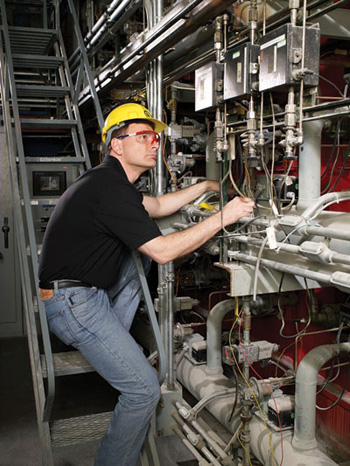
Photo 9. A UL engineer evaluates a piece of industrial equipment as part of a UL Field Evaluation on uncertified equipment.
UL factory Follow-up audit inspection is required of all UL certified products. This process entails UL Field Services staff making periodic unannounced visits to manufacturers’ factories to conduct production line testing and verify continued compliance with UL’s requirements by auditing for compliance with the report written during the Listing evaluation. This verifies the product is being made the same way as when UL tested it. Factory Follow-up visits occur typically a minimum of four times a year and may be as frequent as every day depending on type of product and the manufacturer’s quality control.
Is a CE Mark a Listing Mark?
No, the CE Mark is not a Listing Mark. The CE Mark is an acronym for Conformité Européenne, French for European Conformity. The CE marking is a manufacturer’s self-attestation that his product complies with the essential requirements of the applicable European laws or directives. It is not a third party certification system.
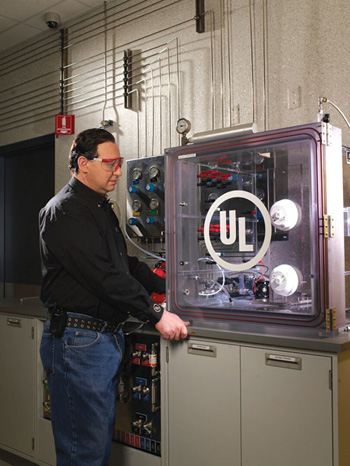
Photo 10. A UL lab tech conducts testing on carbon monoxide (CO) detectors in UL’s CO gas detector lab.
The CE Marking is required on products in the countries of the European Economic Area (EEA) to facilitate trade between the member countries.
Unlike the UL Mark, the CE Mark:
- Is not a safety certification mark,
- Is generally based on self-declaration rather than third-party certification, and
- does not demonstrate compliance to North American safety standards or our installation codes such as the NEC.
Recently UL’s Field Evaluation group started keeping statistics on field evaluations conducted on uncertified equipment that carried only a CE Marking. The results are quite telling. On field evaluations completed by UL over the last nine months (June 2007–March 2008), 90 percent of the equipment with only a CE Marking, had one or more deficiencies that did not comply with the recognized U.S. standards or requirements applicable to the equipment. That means 9 out of 10 pieces of field-evaluated equipment that carried only the CE Marking on the product did not comply with the applicable U.S. safety requirements.
For more information on the CE Mark, see page 38 in the 2007 UL White Book or online atwww.ul.com/regulators/CEmarkinfo.cfm
Does UL List Industrial Machinery?
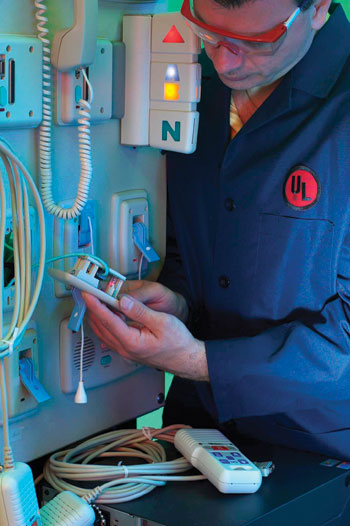
Photo 11. A UL lab technician evaluates hospital nurse call equipment.
While in some areas of the country there is a push to exempt industrial machinery from listing, it seems that many people may not be aware that there are Listing requirements for industrial machinery and that a UL product category does exist for this type of equipment. UL Lists industrial machinery under the category of Factory Automation Equipment (GPNY) located on page 135 in the 2007 UL White Book. Factory Automation Equipment uses the requirements in UL Subject 2011, “Outline of Investigation for Factory Automation Equipment.” This equipment is intended to be installed in accordance with ANSI/NFPA 79, “Electrical Standard for Industrial Machinery,” and Article 670 of ANSI/NFPA 70, National Electrical Code. Presently, more than 45 manufacturers have Listing under this category. Here is a sampling of some of the different types of equipment that is Listed as Factory Automation Equipment, plastic injection molders, automated labeling machines, CNC milling machines, wave solderers and automated assembly lines.
UL can also conduct field evaluations on industrial machinery to the same requirements. If interested in a field evaluation, please contact UL’s Customer Service at 877-854-3577, and select prompt No. 2 or contact us online atwww.ul.com/field.
Conclusion
In a slowing economy, sustained economic development is an important issue; however, it does not outweigh the importance of worker safety and the safeguarding that Code compliance provides. Products listed by a third party testing laboratory such as UL provide one of the cornerstones of the U.S. safety system providing protection from electric shock, fire and personal injury to the general public and North American workers. A Listing Mark provides confidence and peace of mind that a product has been evaluated for compliance with nationally recognized safety standards. These safety standards set the bar for minimum product safety requirements that include construction as well as performance and factory verification. A listed product is a known entity that goes a long way to assuring a code-compliant installation, a safe workplace and the protection of our loved ones.
Products that are not listed or that carry only a CE Marking are wild cards, the unknowns; we know little about them except perhaps they can be sold in Europe. There is no indication that the product meets any safety standards or will be code-compliant. Why take a chance on an unlisted product?










Find Us on Socials